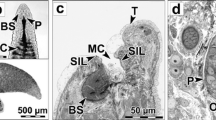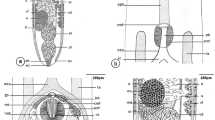Summary
In a study on 20 species of digenetic trematodes belonging to 13 families we could recognise six basic histological conditions (1). Gastrodermis of uniform height without any brush border (2). Gastrodermis of uniform height but with microvilli (3). Gastrodermis which presents pyramidal ridges projecting into the lumen in the absence of food but more or less of uniform height in the presence of food. In both the stages characteristic microvilli make their appearance (4). Gastrodermis presents two different stages—when the lumen is free of food the cells are club-shaped or columnar or cylindrical and when food is present it shrinks to flat or cuboidal gastrodermis (5). Two stages of gastrodermis as mentioned in the previous condition but the brush border makes its appearance only in the flat cell condition (6). Two stages of gastrodermis—in both the stages the brush border is present. Thus six different gastrodermal organisations could be made out. The histological structure seems to be independant from the family to which the parasite belongs or its habitat or food habits.
Similar content being viewed by others
References
Bennet, C.E.:Fasciola hepatica: Development of caecal epithelium during migration in the mouse. Exp. Parasitol.37, 426–441 (1975)
Bogitsh, B.J.: Cytochemical and biochemical observations on the digestive tracts of digenetic trematodes. IX.Megalodiscus temperatus. Exp. Parasitol.32, 244–266 (1972)
Chubrick, G.K.: Character of the structure and secretory activity of intestinal epithelial cells ofDiplodiscus subclavatus. Parasitologia4, 43–47 (1970)
Chubrick, G.K.: Morphology and functional variability of intestinal epithelium of certain treamatodes. Trudy Vsesoyuznogo Instituta Gel'mintologii im K.J. Skryabina.17, 133–137 (1971)
Dawes, B.: A histological study of the caecal epithelium ofFasciola hepatica L. Parasitology52, 483–493 (1962)
Dawes, B.: The migration of juvenile forms ofFasciola hepatica L through the wall of intestine in the mouse with some observations on food and feeding. Parasitology53, 109–122 (1963a)
Dawes, B.: Hyperplasia of the bile duct in Fascioliasis and its relation to the problem of nutrition in the liver flukeFasciola hepatica L. Parasitology53, 123–133 (1963b)
Dawes, B.: Some observations ofFasciola hepatica L during feeding operation in the hepatic parenchyma of the mouse, with notes on the nature of liver damage in this host. Parasitology53, 135–143 (1963c)
Dawes, B.:Fasciola hepatica—a tissue feeder. Nature198, 1011–1012 (1963d)
Grembergen, G. Van: Au sujet de la nutrition chezFasciola hepatica. Annales de la Société Royale Zoologique de Belgique81, 15–20 (1950)
Gresson, R.A.R., Threadgold, L.T.: A light and electron microscope study of epithelial cells of the gut ofFasciola hepatica L. J. Biophys. Biochem. Cytol.6, 157–162 (1959)
Halton, D.W.: Occurence of microvilli-like structures in the gut of digenetic trematodes. Experientia22, 828–830 (1966)
Halton, D.W.: Observations on the nutrition of digenetic trematodes. Parasitology57, 639–660 (1967)
Howell, M.J.: Some aspects of nutrition inPhilophthalmus burrili (Trematoda: Digenea). Parasitology67, 133–144 (1971)
Jennings, J.B.: Digestion in flat worms. In: Chemical Zool., M. Florkin and B. Scheer, eds., Vol. 2, New York: Academic Press 1968
Kublickiene, O.: Histological studies on feeding inFasciola hepatica, (Abstract) Tez. Dokl. (Mater) nauch. Konf. Vses. Cbshch. Helmint., Part I: 100–101 (Russian) (1962a)
Kublickiene, O.: Some data on the nutrition of trematodeFasciola hepatica (Histologic study). Acta Parasitol.4, 23–34 (1962b)
Muller, W.: Die Nahrung vonFasciola hepatica und ihre Verdauung. Zool. Anz.57, 273–281 (1923)
Overstreet, R.M., Martin, D.M.: Some digenetic trematodes from synaphobranchid eels. J. Parasitol.60, 80–84 (1974)
Read, C.P.: Nutrition of intestinal helminths. In: Biology of parasites. E.J.L. Soulsby, ed., New York: Academic Press 1966
Robinson, G., Threadgold, L.T.: Electron microscopic studies ofFasciola hepatica. III. The fine structure of the gastrodermis. Expl. Parasitology37, 20–36 (1975)
Stephenson, W.: Physiological and histochemical observations on the adult liver flukeFasciola hepatica. II. Feeding. Parasitology38, 123–127 (1947)
Wotton, R.M., Sogandares-Bernal, F.: A report of the occurence of microvilli-like structures in the caeca of certain trematodes (Paramphistomatidae). Parasitology53, 157–161 (1963)
Author information
Authors and Affiliations
Rights and permissions
About this article
Cite this article
Lakshmi, V.V., Rao, K.H. Observations on the structure and histology of the gut in some digenetic trematodes. Z. Parasitenkd. 56, 55–61 (1978). https://doi.org/10.1007/BF00925937
Received:
Issue Date:
DOI: https://doi.org/10.1007/BF00925937




